When you purchase a sewing machine, it comes with some basic accessories that are essential to your sewing experience. These accessories may seem small and insignificant, but they are must-have tools that you should not overlook. If you want to get the most out of your sewing machine, you need to use the right accessories. They will make your projects easier, and even save you time and money.
This guide will provide you with an overview of the different accessories available for sewing machines. We’ll cover the essential accessories that every sewing machine owner should have:
- #1. Presser Feet
- #2. Bobbins
- #3. Needles
- #4. Thread
- #5. Thread Stand
- #6. Thread Caps
- #7. Scissors For Sewing Machines
- #8. Cleaning Brush
- #9. Seam Ripper
- #10. Needle Threader
- #11. Sewing Machine Oil
- #12. Screwdrivers For Sewing Machines
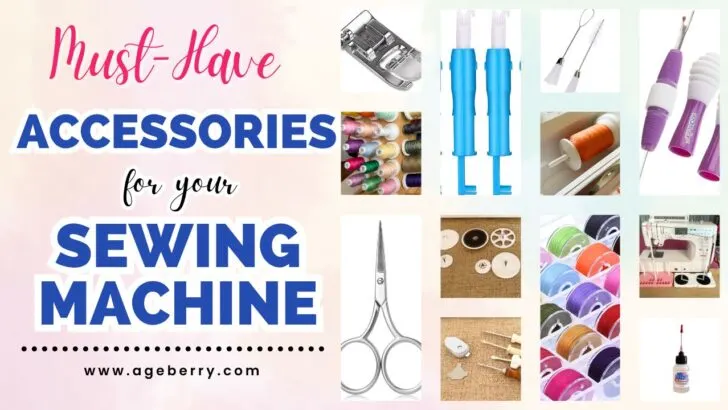
#1. Presser Feet
Even the most basic sewing machine requires a presser foot to function properly. So, what exactly is a presser foot and why is it so important?
Simply put, a presser foot is an attachment that is used to hold fabric in place while it is being sewn. Without a presser foot, fabric would move around and become misaligned, resulting in uneven stitches and a poorly finished product.
While there are many types of presser feet available, there are three basic ones that every beginner should know about: the all-purpose presser foot, the zipper presser foot, and the buttonhole presser foot.
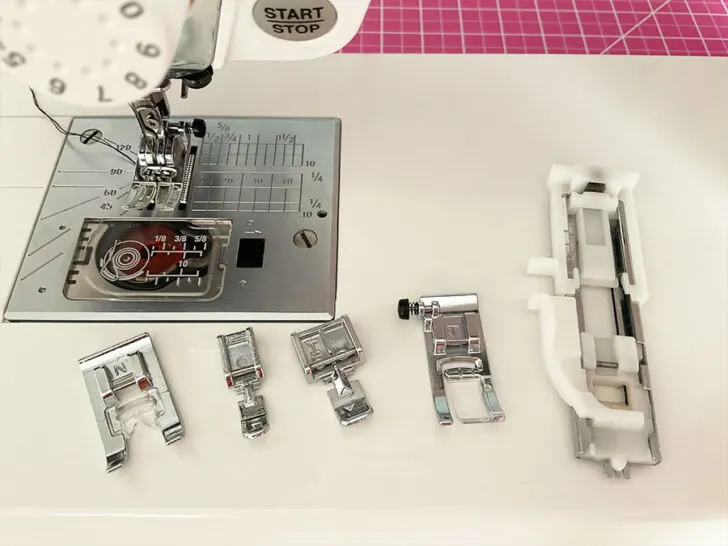
The all-purpose presser foot is the most commonly used presser foot and is included with most sewing machines. As the name suggests, it can be used for a wide variety of sewing tasks, including basic straight stitching, zigzag stitching, and even some decorative stitching. This versatile presser foot is a must-have for any sewist, as it can be used for everything from making curtains to hemming pants.
The zipper presser foot is another important tool for any sewing project that involves a zipper. This foot has two sides that can be adjusted to fit the width of the zipper, ensuring that it is sewn in straight and evenly. Without a zipper presser foot, zippers can be difficult to sew in and may end up crooked or puckered.
The buttonhole presser foot is essential for any project that involves buttons. This foot has a small slit in the middle that allows the needle to sew a buttonhole in the fabric. Without a buttonhole presser foot, creating buttonholes can be a tedious and time-consuming process.
✅ Related tutorial: Buttonhole Presser Foot 101: What It Is And How To Use A Buttonhole Foot To Create Nice Buttonholes
While these three presser feet are essential for any beginner, there are many other types of presser feet available that can be used for more specialized tasks. For example, a walking foot can be used to sew through multiple layers of fabric, while a free-motion quilting foot is designed for quilting and other decorative stitching.
✅ Related tutorial: Sewing Machine Presser Feet
Note: Some of the links on this page are affiliate links. This means I will receive a commission if you order a product through one of my links. I only recommend products I believe in and use myself.
#2. Bobbins
Bobbins are another essential accessory for any sewing machine, as they play a crucial role in the stitching process. But what exactly is a bobbin, and why are bobbins necessary?
A bobbin is a small, cylindrical spool that holds the thread that is used to create the bottom stitches in a sewing project. Simply put, bobbins are essential for creating high-quality, even stitches in a sewing project. Without a bobbin, the thread used in a sewing project would be loose and uneven, resulting in a finished product that looks messy and unprofessional. By using a bobbin, the thread is held in place and can be used to create a wide variety of stitches, from basic straight stitches to decorative embroidery.
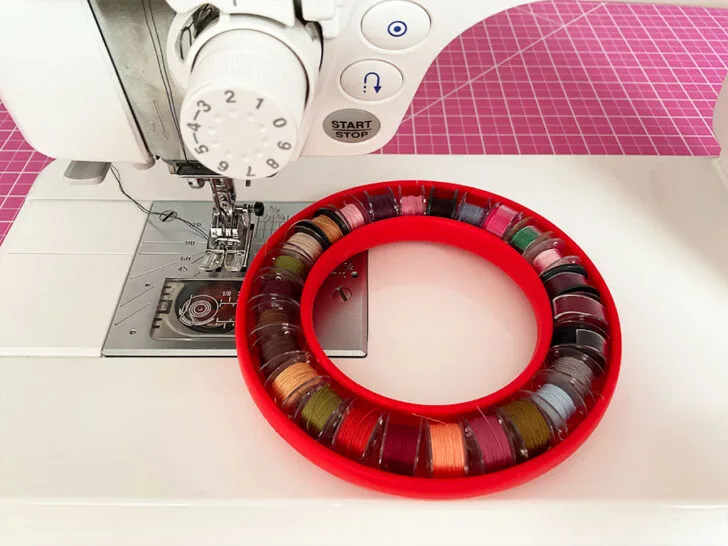
There are many different types and sizes of bobbins available, including plastic bobbins, metal bobbins, and even pre-wound bobbins. You need to choose the correct type of bobbin for your sewing machine, as using the wrong type can cause stitching problems and potentially damage your machine.
The small accessory box that comes with your sewing machine usually includes only a few empty bobbins, which is not enough if you like sewing. You can purchase additional bobbins and have a good supply on hand. Here is the link to Amazon.
Filling a bobbin is a simple process that involves placing the bobbin on a spindle and using the sewing machine to wind the thread onto the spool. It is important to wind the thread evenly and to not overfill the bobbin, as this can cause the thread to become tangled and break while sewing.
✅ Related tutorial: How to thread a bobbin
Once the bobbin is filled, it must be inserted into the sewing machine. The exact process for inserting a bobbin varies depending on the type of machine, but it typically involves opening a small compartment on the machine and placing the bobbin inside. Follow the manufacturer’s instructions for your specific machine to ensure that the bobbin is inserted correctly.
✅ Related tutorial: Bobbin Thread 101: Answers to Your Frequently Asked Questions
#3. Needles
When it comes to sewing machine accessories, needles are an absolute must-have. Without a needle, a sewing machine simply cannot function.
They come in a variety of sizes and types, each designed for a specific purpose.
One of the most common types of needles is the universal needle. The name “universal” reflects their ability to work with a wide range of fabrics, making them a go-to option for many projects. They are available in many different sizes, ranging from very fine needles for delicate fabrics to heavy-duty needles for thick materials.
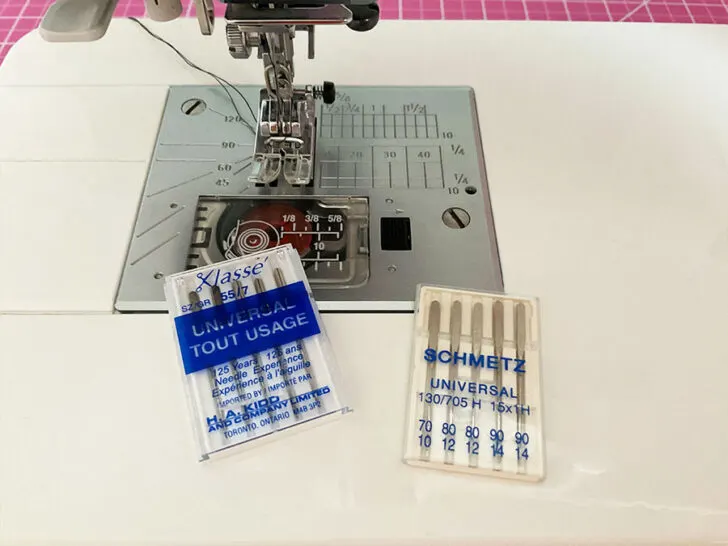
The most common sizes of universal needles range from 60/8 to 110/18. There are other sizes but they are not common. The smaller sizes, such as 60/8 and 70/10, are perfect for lightweight fabrics like silk and chiffon. Medium sizes, such as 80/12 and 90/14, are suitable for medium-weight fabrics like cotton and linen. The larger sizes, such as 100/16 and 110/18, are ideal for heavy-duty fabrics like denim and leather.
✅ Related tutorial: Sewing Machine Needle Sizes Explained
When choosing the size of your universal needle, consider the weight and type of fabric you’ll be working with. A needle that is too small may break or bend when used with heavy fabrics, while a needle that is too large may leave visible holes in delicate fabrics.
While Universal sewing machine needles are perfectly fine for most projects, there are times when a specialized needle can make all the difference. For example, if you’re working with heavy-duty fabrics like denim or leather, a denim needle or leather needle can help you sew through the material easier and prevent skipped stitches.
And if you’re working with knits or stretchy fabrics, a ballpoint needle or stretch needle can help prevent the fabric from getting snagged or damaged.
There are many other types of needles, for example, fleece needles, which are designed for use with fleece fabric, embroidery needles, which are used for machine embroidery, or hemstitch needles, that are specifically designed for decorative stitches. While these specialized needles are not necessarily must-haves, they can be very helpful if you like to sew a variety of different projects and fabrics.
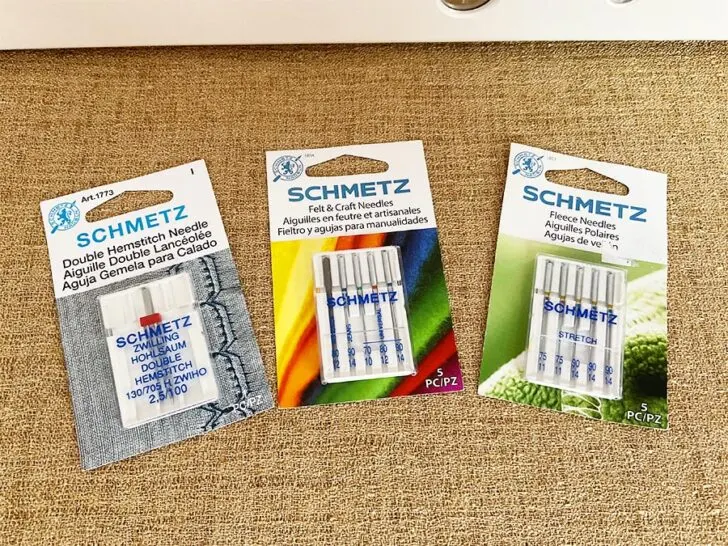
It is important to choose the correct type and size of needle for your specific sewing project, as using the wrong needle can result in broken threads, skipped stitches, and even damage to your machine. For example, Schmetz needles are a popular brand of needles that are known for their high quality and durability.
✅ Related tutorial: Sewing Needle
You can easily purchase sewing machine needles of different sizes and types on Amazon, making it easy to stock up on the needles you need for your next project. Here is a link to a selection of sewing machine needles on Amazon.
#4. Thread
Thread is another must-have accessory for any sewing machine and comes in a wide variety of types, weights, and colors. By choosing the right thread for your specific project, you can ensure that your stitches are even, your thread does not break, and your project turns out beautifully.
There are many different types of thread available, each designed for a specific purpose. For example, cotton thread is a popular choice for quilting, while polyester thread is often used for general sewing projects. Nylon thread, on the other hand, is a strong and durable option that is often used for heavy-duty materials like leather or canvas.
✅ Related tutorial: Sewing thread types and uses
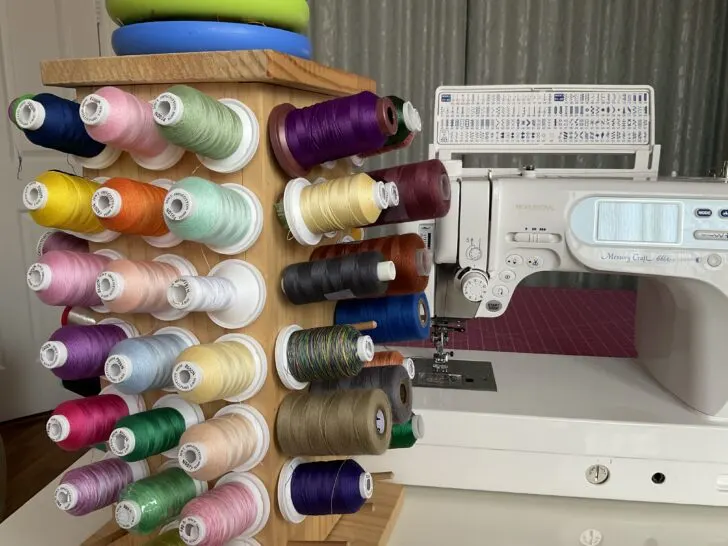
Thread weight is another important consideration when choosing the right thread for your project. Thread weight refers to the thickness of the thread, with lower numbers indicating a thicker thread and higher numbers indicating a thinner thread. A general rule of thumb is to use a lighter weight thread for lighter weight fabrics, and a heavier weight thread for heavier weight fabrics.
✅ Related tutorial: Sewing thread sizes and how to choose
The most commonly used thread weights are 30, 40, and 60. Each weight is suitable for different types of sewing projects.
30 weight thread is a heavier and thicker thread that is ideal for sewing heavy weight fabrics, some decorative stitching, and quilting. This thread weight is great for creating bold and visible stitches that stand out on the fabric.
40 weight thread is a medium-weight thread that is suitable for a wide variety of sewing projects. It is the most commonly used thread weight and is ideal for general sewing, garment construction, and machine quilting. This thread weight is strong enough to create durable seams and is thin enough to be used in most sewing machines without causing problems.
60 weight thread is a finer and thinner thread that is ideal for delicate fabrics and lightweight materials. This thread weight is great for creating invisible seams and for topstitching on lightweight fabrics. It is also perfect for machine embroidery and applique, where the thread needs to be thin and unobtrusive.
When choosing the right thread for your project, consider both the type of thread and the weight of the thread. For example, if you are sewing a delicate fabric like silk, you may want to choose a lightweight thread like size 60 silk thread or cotton thread. If you are sewing a heavy-duty material like denim, you may want to choose a heavier weight thread like size 30 polyester thread.
In addition to the type and weight of the thread, it is also important to consider the color of the thread. Choosing a thread color that matches your fabric can help to create a seamless, professional-looking finish.
So next time you sit down at your sewing machine, make sure that you have the right thread for the job.
Threads are usually not included in a sewing machine accessories kit, or if they are included, it is only a small amount. This means that you will need to purchase threads separately for your sewing projects. You can buy threads in bulk or purchase them for each individual project.
White and black are the most commonly used thread colors for home sewists, as they are versatile and can be used with a wide variety of fabrics. However, it is always a good idea to have a range of thread colors on hand to match different fabrics. Here is a link to a selection of sewing threads on Amazon
#5. Thread Stand
A thread stand is a must-have accessory for any sewing machine, as it plays a crucial role in ensuring smooth, even stitching.
A thread stand holds the thread spool above the sewing machine, allowing the thread to flow smoothly and preventing tangles or knots. There are many different types of thread stands available, including standalone thread stands and integrated thread stands that are built into the sewing machine itself.
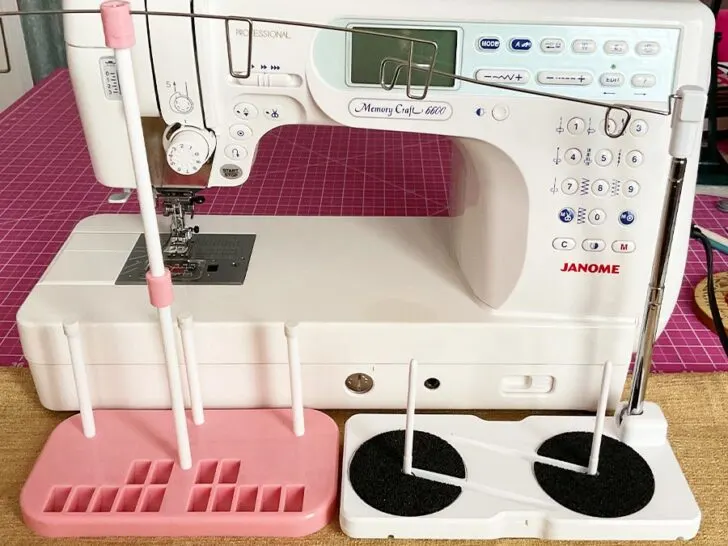
Standalone thread stands are often preferred by sewists, as they allow for greater flexibility in thread placement and can be used with a wide variety of sewing machines. They are available in many different sizes and styles, from simple wire stands to more elaborate stands that feature multiple spool holders and adjustable height settings.
✅ Related tutorial: What is a Sewing Thread Stand for a Sewing Machine, and Why Do I Need One?
Integrated thread stands, on the other hand, are built directly into the sewing machine and are designed to hold the thread spool in a specific position. While these stands can be convenient, they may not be as versatile as standalone thread stands.
When choosing the right thread stand for your sewing machine, consider the size and weight of your thread spools, as well as the overall size of your sewing machine. You will want to choose a thread stand that is compatible with your machine and can hold the size and weight of thread spools that you typically use. Here is a link to a selection of thread stands on Amazon
#6. Thread Caps
Thread caps are an often-overlooked accessory for sewing machines, but they are a must-have accessory for modern sewing machines.
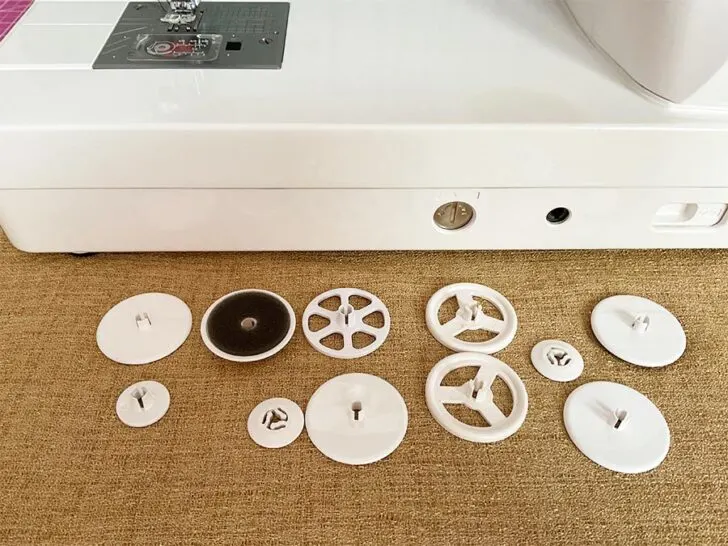
They are small plastic pieces that are used to secure the thread in place on the sewing machine. They are designed to keep the thread from unraveling or slipping out of place during sewing, which can lead to uneven stitches or even damage to the machine.
There are different types and sizes of thread caps available, often designed for a specific machine. They can be easily removed and replaced as needed.
When choosing the right thread cap for your project, consider the size of thread spool that you will be using.
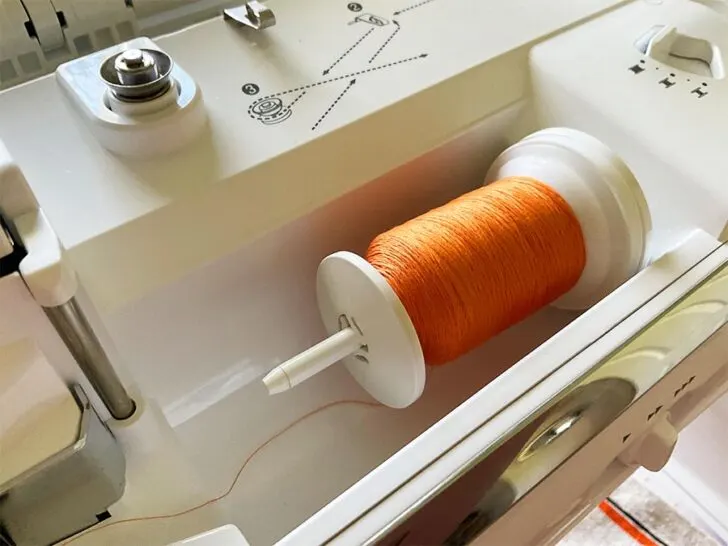
#7. Scissors For Sewing Machines
Scissors are a must-have accessory for any sewing machine, as they are essential for cutting threads. Scissors for sewing machines are small, lightweight scissors that are easy to maneuver. They are designed specifically for cutting threads. They are different from fabric shears, which are larger and designed for cutting fabric.
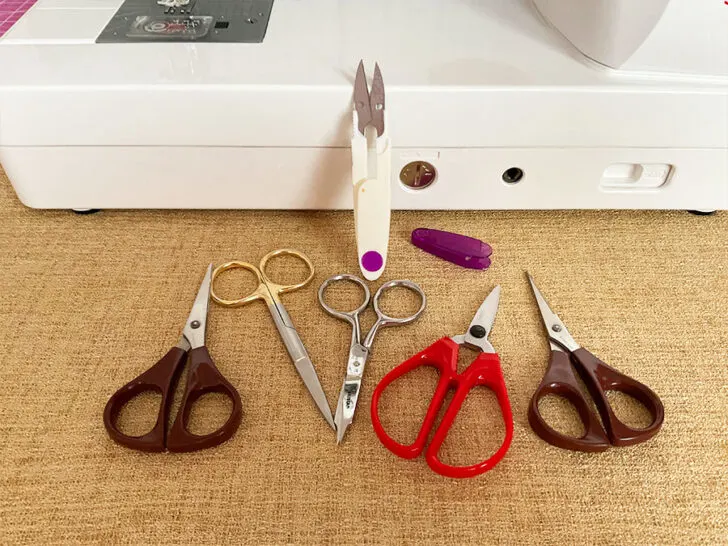
While fabric shears can be used for cutting thread on a sewing machine, they are often too big and awkward to use for this purpose. Fabric shears are designed for cutting larger pieces of fabric and are not ideal for precision cutting of thread.
This is where small scissors for sewing machines come in handy.
In addition to being more comfortable to use, small scissors for sewing machines are also more precise. They often feature a pointed tip that allows for precise cutting of thread in tight spaces, while also being sharp enough to make clean cuts.
✅ Related tutorial: Cutting Tools For Sewing: The Ultimate Guide
One popular type of small scissors for sewing machines is snips, which are small, spring-loaded scissors that are designed for cutting thread quickly and easily. They are often used for quilting and other projects that require frequent thread cutting.
Make sure that your scissors are sharp and well-maintained. Dull scissors require more effort to make a clean cut, which can lead to frustration. This can be especially true when working on a large project that requires frequent cutting of thread.
I looked on Amazon for the best options, and want to share my top picks with you. Check out these small scissors on Amazon through my affiliate link here.
#8. Cleaning Brush
Cleaning your sewing machine is necessary for maintaining its longevity and performance. One of the must-have accessories for cleaning your sewing machine is a specialized cleaning brush, which is designed to reach into tight spaces. It can make all the difference in keeping your machine in tip-top shape.
Use the brush to gently sweep away any dust and lint from the bobbin case, feed dogs, and other hard-to-reach areas. Be sure to avoid using any liquids or cleaning solvents, as these can damage your machine’s delicate parts.
If you’re a sewing enthusiast with multiple machines, you may be familiar with the struggle of keeping track of all the small accessories that come with each machine. For me, one of the most commonly lost accessories is the cleaning brush.
They are small and easy to misplace. Sometimes I spend lots of time searching for that elusive cleaning brush that seems to disappear every time I need it.
But the solution is simple: stock up on cleaning brushes. You can easily purchase sets of cleaning brushes for sewing machines on Amazon for a very reasonable price. Here is a link to a selection of cleaning brushes for sewing machines and sergers on Amazon.
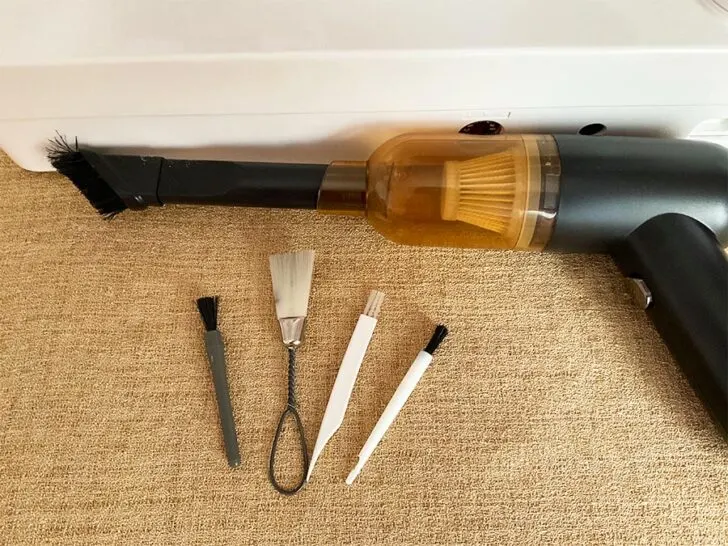
I recently discovered another solution to the problem of keeping my sewing machines and sergers clean: a mini vacuum! I found that using a mini vacuum, like the ones used for cleaning car interiors or computers, is really effective for removing dust and debris from my machines. The vacuum’s tiny nozzle can easily reach into tight spaces and remove even the tiniest particles.
Just be sure to use a vacuum with a small brush attachment to avoid damaging your machine’s delicate parts.
If you’re interested in learning more about mini vacuums and how they can help keep your machines clean, check out my guide Choosing a Mini Vacuum for a Sewing Machine. The guide includes my thoughts on a few different mini vacuums.
#9. Seam Ripper
A seam ripper is the tool that probably every sewist hates. But let’s face it, we all make mistakes, and sometimes we need to undo our stitches and start again. That’s where the seam ripper comes in, and that’s why it’s a must-have accessory for any sewing machine owner.
Seam rippers are usually included in a tool kit for sewing machines because they are essential for removing unwanted stitches. They are designed to cut through the thread without damaging the fabric, making it easy to undo your work and start over.
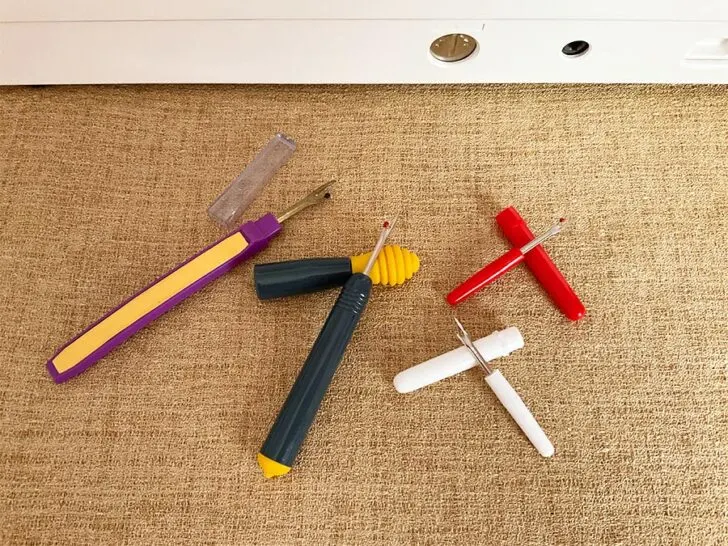
But did you know that there are different types of seam rippers available for purchase separately? That’s right – you can choose from a variety of seam rippers to suit your needs and preferences.
There are standard seam rippers with a sharp blade and a pointed end, as well as ergonomic seam rippers with a comfortable grip that reduces hand fatigue. I have tried my fair share of seam rippers over the years. My absolute favorite is one that’s sometimes called the “magic eraser”. This little tool has saved me hours of frustration. You can purchase it on Amazon.
The “magic eraser” is a seam ripper that has a sharp blade on one end and a rubber eraser on the other. This unique design allows you to easily rip out seams with the blade, and then remove any remaining threads or fuzz with the eraser. It’s like having two tools in one!
In my article How to use a seam ripper, I go into more detail about the “magic eraser” and how to use it effectively.
There are also electric seam rippers that make quick work of removing stitches but I didn’t try the yet.
There are even seam rippers with built-in magnifying glasses for those of us who need a little extra help seeing the stitches!
#10. Needle Threader
Needle threaders are a must-have accessory for any sewing machine owner, especially for those who may struggle with threading the needle by hand.
Needle threaders typically consist of a small wire loop that is used to guide the thread through the eye of the needle. To use a threader, simply insert the wire loop through the eye of the needle, then thread the end of the thread through the loop and pull it through the eye of the needle. It’s that simple!
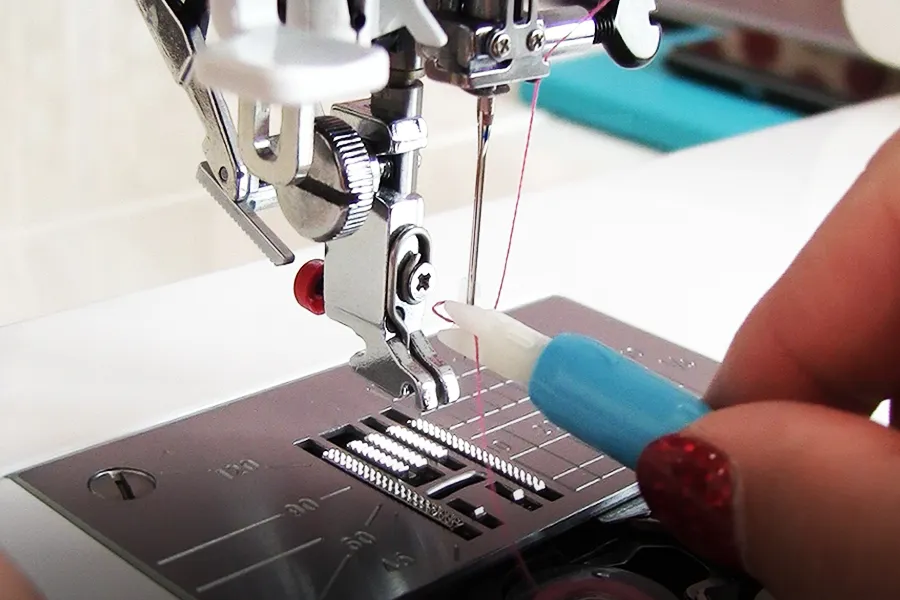
✅ Related tutorial: How To Use A Needle Threader For Sewing Machine And Hand Sewing
One of the main benefits of using a threader is that it can save you time and frustration. With a threader, you can quickly and easily thread the needle without struggling to see or hold the thread in place.
Another benefit of using a threader is that it can help prevent damage to a needle. When you try to thread the needle by hand, you may accidentally hit the needle against the machine, causing it to bend.
Here is a link to a selection of needle threaders for sewing machines on Amazon. You’ll find a variety of options to choose from.
Many modern sewing machines come with built-in threaders, which is a convenient and time-saving feature.
✅ Related tutorial: How to thread a needle on a sewing machine
#11. Sewing Machine Oil
Sewing machine oil is another must-have accessory for a sewing machine owner, as it can help keep your machine running smoothly and extend its lifespan. However, many modern sewing machines don’t require oiling at all.
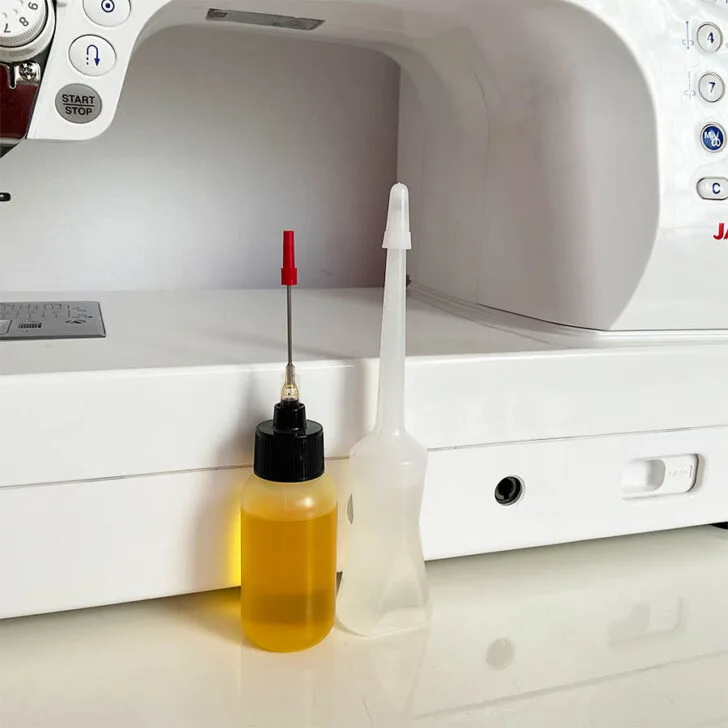
In the past, sewing machines were made with many metal parts that needed to be lubricated with oil to prevent rust and wear. However, many modern machines are made with plastic and other materials that don’t require oiling. Instead, these machines may need to be serviced by a professional in a shop to ensure that they are running properly.
I have written a detailed guide on sewing machine oil that you can check out on my site – Sewing Machine Oil | Top 10 Questions Answered.
If you’re unsure whether your sewing machine requires oiling, check the manufacturer’s instructions. Using oil on a machine that doesn’t require it can cause damage and may void your warranty.
For machines that do require oiling, use the right type of oil and to apply it correctly. Sewing machine oil is specially formulated to lubricate and protect the metal parts of your machine. Use only sewing machine oil, as other oils may be too thick or may contain additives that can damage your machine.
You can purchase sewing machine oil on Amazon at a very affordable price. Choose an oil that is compatible with your machine and made from high-quality materials and consider purchasing from a reputable brand or seller. Here is a link to a selection of sewing machine oils on Amazon
#12. Screwdrivers For Sewing Machines
Screwdrivers are an essential tool for any sewing machine owner, as they are necessary for making adjustments, customizations and repairs to the machine. Here are some instances where you might need to use a screwdriver on your sewing machine:
- Changing the presser foot holder
- Opening the throat plate for cleaning
- Changing needles on some machines
- Changing bobbin tension
- Adjusting the bobbin case
Screwdrivers for sewing machines typically come in a tool kit that is specific to the machine. They are often very small, as the screws on sewing machines are also small. This means that they can be easy to misplace or lose, so it’s important to keep them in a safe place.
When I bought my Janome 6600 sewing machine I found this flat piece of metal in the tool box. After reading the manual, I found out that this was actually a very useful screwdriver. Its unique shape allowed me to easily access the screws for removing the needle plate or for changing the presser foot holder.
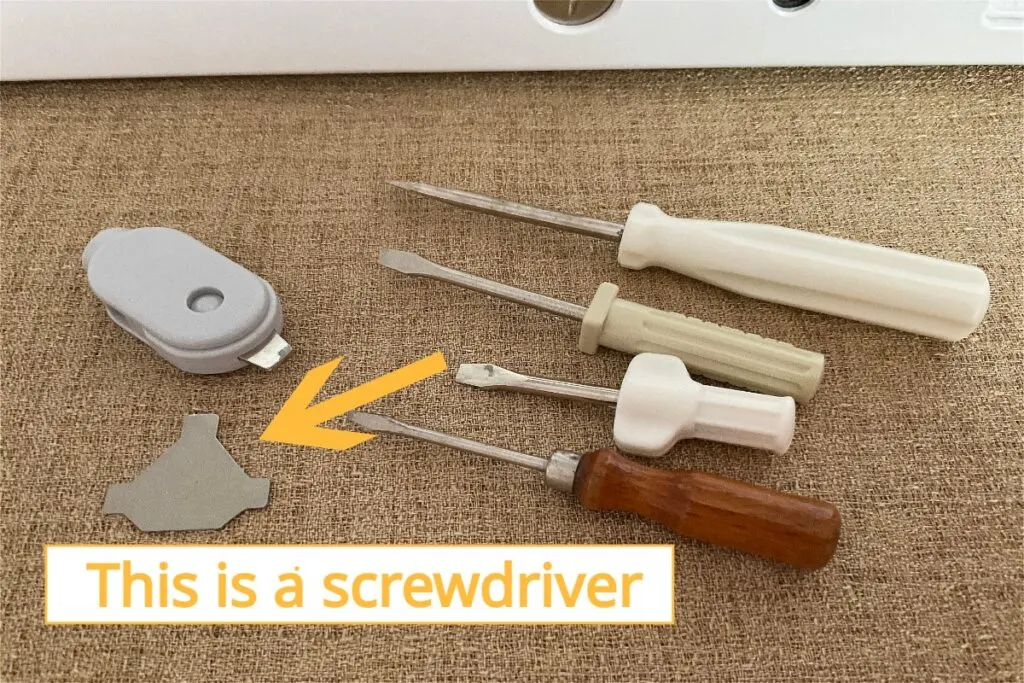
Did you find my guide on must-have sewing machine accessories helpful? If so, you may be interested in my guide on troubleshooting common sewing machine problems and their solutions. In this guide, I cover a range of issues that can arise with sewing machines, from thread tension problems to machine jamming. With step-by-step instructions for diagnosing and fixing each issue, this guide is an essential resource for any sewist. So, if you want to keep your sewing machine running smoothly and avoid costly repairs, check out my guide Troubleshooting Common Sewing Machine Problems (+ Solutions)
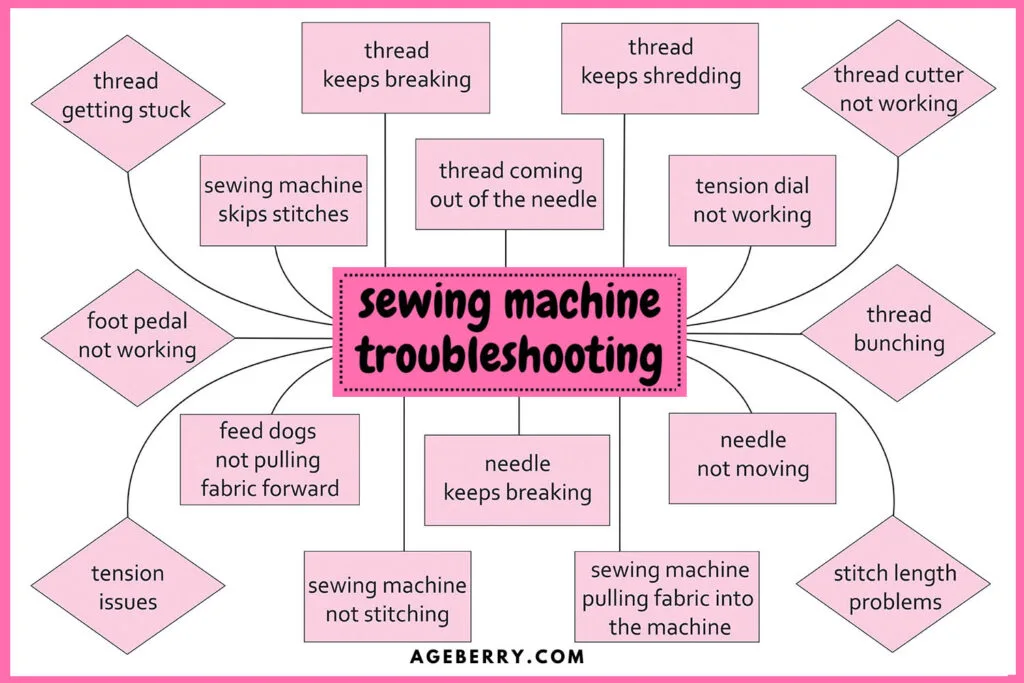
If you found this guide on must-have sewing machine accessories helpful, save this pin (see below) on your sewing board so you can easily come back to it later , and follow me on Pinterest to stay up-to-date on all the latest and greatest in the world of sewing.
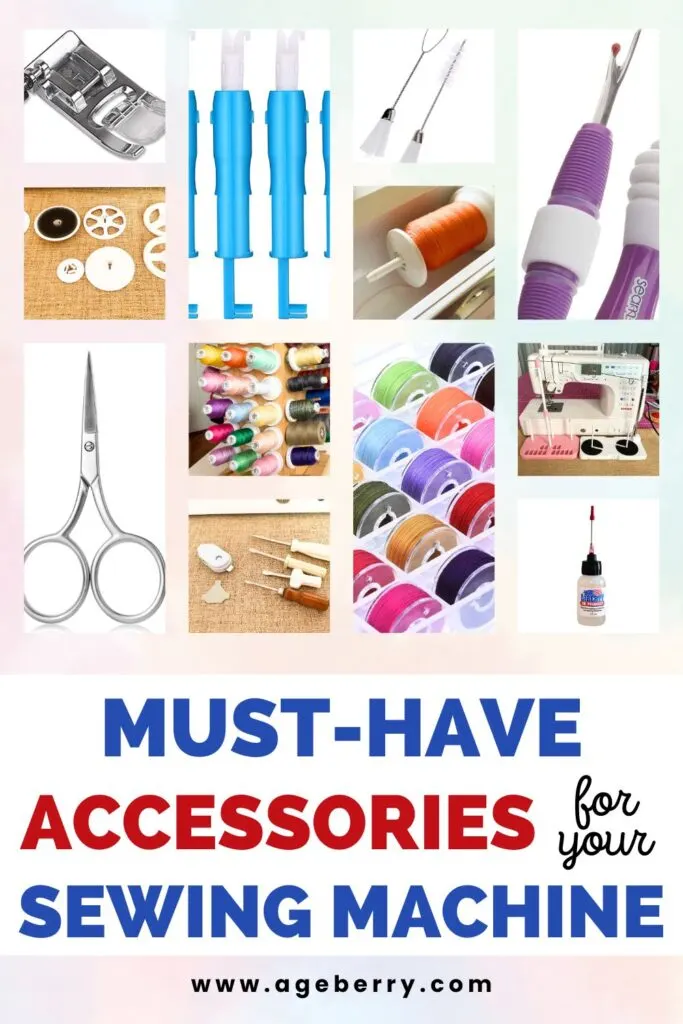
latest posts
- Knot a Problem: Easy Ways to Secure Short Thread Ends
- Ever Tried This on Your Serger? This Differential Feed Feature Will Amaze You
- Ditch My Sewing Machine? Not in This Lifetime!
- Adorable DIY Needle Book | Easy Tutorial for Beginners
- Master the Seam Ripper: Your Ultimate Guide to Precision Stitch Removal
- Think You Know Zippers? This Installation Guide Might Surprise You
- Why Does Your Seam Ripper Have a Red Ball? Discover Its Purpose!
- Topstitching Troubles? This Simple Trick Will Turn It Around Instantly!
- How to Sew Shirring: A Step-by-Step Guide to Elastic Thread Gathering



